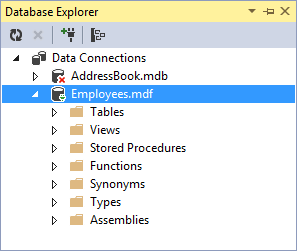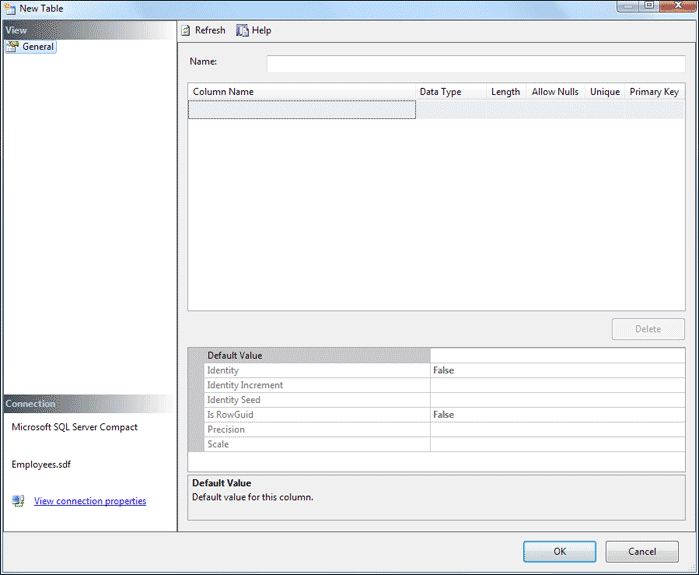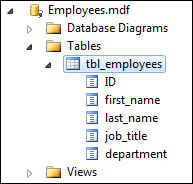Now that you have created the database itself, you need to create at least
one table to go in it.
To create a table, right click on the database in the Solution Explorer. From the menu that appears, select Open:
 When you click Open, you'll see the Database Explorer appear on the left hand
side of your screen:
When you click Open, you'll see the Database Explorer appear on the left hand
side of your screen:
 To create a new table, right click on Tables. From the menu that appears,
select Add New Table:
To create a new table, right click on Tables. From the menu that appears,
select Add New Table:
(In Visual Studio Express 2010, you may get an error message along the lines of "This server version is not supported. Only servers up to Microsoft SQL Server 2008 are supported." If you do, you'll need the SQL Server Data Tools from here:
If you still get no joy creating tables in your database after downloading the SQL Server Data Tools then you can use our database. You'll find the Employees database in the extra files here on our site: extra files. You can add it as a resource later.)
When you click on Add New Table you should see the table designer open up in the centre of your screen. This will be a different designer, depending on which version of Visual Studio Express you have. For VS Express 2013 users, click here to go to your section:
For VS express 2010 and 2012 users, when you click Create Table or Add New Table, you'll see a dialogue box appear. This one:
 This screen is where you set up the Columns that go in the table. You'll get
to enter the actual data later. But you need to tell SQL Server what kind of
data (Data Type) is going into each column.
This screen is where you set up the Columns that go in the table. You'll get
to enter the actual data later. But you need to tell SQL Server what kind of
data (Data Type) is going into each column.
First, though, type a name for your table in the Name box at the top. Call the table tbl_employees.
For the first column in the table, type ID in the in the Column Name box. You'll then see some more information appear:
 We'll set the ID column as a Primary Key. Click into the Primary Key
box and select Yes from the dropdown list:
We'll set the ID column as a Primary Key. Click into the Primary Key
box and select Yes from the dropdown list:
 For the other values, set the Data Type to int, the Length
to 4, Allow Nulls to No, and Unique to Yes. Your
first column should then look like this:
For the other values, set the Data Type to int, the Length
to 4, Allow Nulls to No, and Unique to Yes. Your
first column should then look like this:
 The Primary Key field, the ID column, will need to have a new integer assigned
every time a new entry is added to the table. In other databases, this is known
as an auto increment number. So that this happens automatically without us having
to worry about it, have a look at the bottom of your Table screen. You should
see a Properties area. Click on Identity and set it to True:
The Primary Key field, the ID column, will need to have a new integer assigned
every time a new entry is added to the table. In other databases, this is known
as an auto increment number. So that this happens automatically without us having
to worry about it, have a look at the bottom of your Table screen. You should
see a Properties area. Click on Identity and set it to True:
 The Increment value is set to 1, meaning the database itself will automatically
add 1 when a new record is added.
The Increment value is set to 1, meaning the database itself will automatically
add 1 when a new record is added.
Using the same technique as above, create the following Column Names, Data Types, Length Allow Nulls, Unique and Primary Key values:
 If you're not too sure about database terminology by the way, here are what
all those headings and values mean:
If you're not too sure about database terminology by the way, here are what
all those headings and values mean:
 Now that you've set up the table, you can start adding data to it. Click the
link below, Add data to your table.
Now that you've set up the table, you can start adding data to it. Click the
link below, Add data to your table.
To create a table, right click on the database in the Solution Explorer. From the menu that appears, select Open:


(In Visual Studio Express 2010, you may get an error message along the lines of "This server version is not supported. Only servers up to Microsoft SQL Server 2008 are supported." If you do, you'll need the SQL Server Data Tools from here:
If you still get no joy creating tables in your database after downloading the SQL Server Data Tools then you can use our database. You'll find the Employees database in the extra files here on our site: extra files. You can add it as a resource later.)
When you click on Add New Table you should see the table designer open up in the centre of your screen. This will be a different designer, depending on which version of Visual Studio Express you have. For VS Express 2013 users, click here to go to your section:
For VS express 2010 and 2012 users, when you click Create Table or Add New Table, you'll see a dialogue box appear. This one:

First, though, type a name for your table in the Name box at the top. Call the table tbl_employees.
For the first column in the table, type ID in the in the Column Name box. You'll then see some more information appear:




Using the same technique as above, create the following Column Names, Data Types, Length Allow Nulls, Unique and Primary Key values:

Data Type - This is the kind of data going
into a table column. The ID column can only have intergers, while all the others
can only have text (nvarchar).
Length - How many characters or digits
the field can hold.
Allow Nulls - A Null value is one where
nothing is set for that field, not even a zero or a blank string.
Unique - This means whether or not you
can have duplicate values in this field
Primary Key - This is used for things like
linking tables together, indexing a long table, and for searching.
Click OK when you've finished adding all the information to the New Table dialogue
box. Your Database Explorer should show you the new table you've just added:
0 comments:
Post a Comment